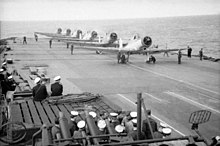| B-24 Skua | |
|---|---|
| Skua L2923, Red-1 of 803 NAS. One of 16 Skuas from RNAS Hatston to attack and successfully sink the Königsberg in Bergen on 10 April 1940. This aircraft spun out on the return flight and crashed, the only aircraft lost on that day. | |
| Role | Dive bomber / Fighter |
| Manufacturer | Blackburn Aircraft |
| Designed by | G.E.Petty |
| First flight | 9 February 1937 |
| Introduced | November 1938 |
| Retired | 1941 (withdrawn from front line) March 1945 (withdrawn from other duties)[1] |
| Primary user | Fleet Air Arm |
| Number built | 192 |
| Variants | Blackburn Roc |
Contents
|
Design and development
Built to Air Ministry specification O.27/34, it was a low-wing monoplane of all-metal (duralumin) construction with a retractable undercarriage and enclosed cockpit. It was the Fleet Air Arm's first service monoplane, and was a radical departure for a service that was primarily equipped with open-cockpit biplanes such as the Fairey Swordfish.Performance for the fighter role was compromised by the aircraft's bulk and lack of power, resulting in a relatively low speed; the contemporary marks of Messerschmitt Bf 109[N 1] made 290 mph (467 km/h) at sea level over the Skua's 225 mph (362 km/h). However, the aircraft's armament of four fixed, forward-firing 0.303 in (7.7 mm) Browning machine guns in the wings and a single flexible, rearward-firing .303 in (7.7 mm) Vickers K machine gun was effective for the time. For the dive-bombing role, a single 250 lb (110 kg) or 500 lb (230 kg) bomb was carried on a special swinging crutch under the fuselage, which enabled the bomb to clear the propeller arc on release. Four 40 lb (20 kg) bombs or eight 20 lb (9 kg) Cooper bombs could also be carried in racks under each wing. It had large Zap-type air brakes/flaps which helped both in dive bombing and landing on aircraft carriers at sea.
Operational history

Production Skua Mk.II, L2928 "S" of 759 sqn.. This aircraft also served with 801 sqn. in the Norwegian Campaign and, flying from RAF Detling, was present at Dunkirk.
Though it fared reasonably well against Axis bombers over Norway and in the Mediterranean, the Skua suffered heavy losses when confronted with modern fighters - particularly the Bf 109 - and they were withdrawn from front line service in 1941. The aircraft was largely replaced by another two-seater, the Fairey Fulmar, which doubled the Skua's forward armament and had a speed advantage of 50 mph (80 km/h). A number of aircraft were converted to target tugs following withdrawal from front line service. Others were in fact completed as target tugs from the factory and used by the RAF and Fleet Air Arm in this role ('Fleet Requirements'). They were also used as advanced trainers for the Fleet Air Arm. The last Skua in service was struck off charge in March 1945.[6]
The Roc was a very similar aircraft developed as a "turret fighter" with all its armament in a dorsal turret. The Roc was expected to serve alongside the Skua. Rocs were attached to Skua squadrons to protect the fleet anchorage at Scapa Flow in early 1940, and briefly from HMS Glorious and Ark Royal during the Norwegian Campaign. Skuas and Rocs flew both fighter sweeps and bombing sorties over the English Channel during Operation Dynamo, and Operation Ariel, the evacuation of Allied forces from Dunkirk and other French ports.[7]
Variants
- Skua Mk.I : 2 prototypes. Powered by the Bristol Mercury, it had distinctive fairings to the engine cowling over the tappet valves of the Mercury. The first prototype, K5178, had a much shorter nose while K5179, the second prototype, had a lengthened nose to improve longitudinal stability.
- Skua Mk.II : Production aircraft powered by the sleeve valved Bristol Perseus. Long nose as per K5179 but with a shorter, smooth cowling. Two-seat fighter and dive bomber for the Royal Navy - 190 built by Blackburn at Brough Aerodrome
Recovery of L2896
In April 2007, the only known nearly complete Blackburn Skua was discovered in Orkdalsfjorden in Norway at 242 metres depth.[8] Due to an engine failure, the Skua, flown by John Casson, leader of 803 Squadron, had to make an emergency water landing in the fjord.[9] Both crew members survived and spent the next five years as prisoners of war. Despite efforts to get the aircraft to the surface as gently as possible, the tail broke off. The engine had become detached in the original ditching. The fuselage, cockpit and wings were salvaged. The Skua will be restored at Norway's aviation museum in Bodø.[10] [11]Operators and units
- Royal Air Force
- RAF Anti-Aircraft Co-operation Units
Specifications (Skua Mk. II)

Skua L3007 in target tug markings, 1941
Data from Fleet Air Arm Archive[1]
General characteristics- Crew: 2
- Length: 35 ft 7 in (10.8 m)
- Wingspan: 46 ft 2 in (14.1 m)
- Height: 14 ft 2 in (4.3 m)
- Wing area: 312 ft² (29.0 m²)
- Empty weight: 5,490 lb (2,490 kg)
- Loaded weight: 8,228 lb (3,730 kg)
- Powerplant: 1× Bristol Perseus XII radial engine, 905 hp (675 kW)
- Maximum speed: 225 mph (195 kn, 360 km/h) at 6,500 ft (2,000 m)
- Range: 800 mi (700 nmi, 1,300 km)
- Service ceiling: 20,200 ft (6,150 m)
- Wing loading: 26.4 lb/ft² (128 kg/m²)
- Power/mass: 0.11 hp/lb (180 W/kg)
- Guns:
- 4 × 0.303 in (7.7 mm) forward-firing Browning machine guns
- 1 × 0.303 in (7.7 mm) Lewis or Vickers K machine gun on flexible mount in rear cockpit
- Bombs: 1 × 500 lb (227 kg) semi-armour piercing bomb or 1 × 250 lb (113 kg) semi-armour piercing/ General Purpose bomb and 4 × 40 lb (18 kg) bombs or 8 × 20 lb (9 kg) bombs
 Unknown
Unknown











0 komentar:
Post a Comment